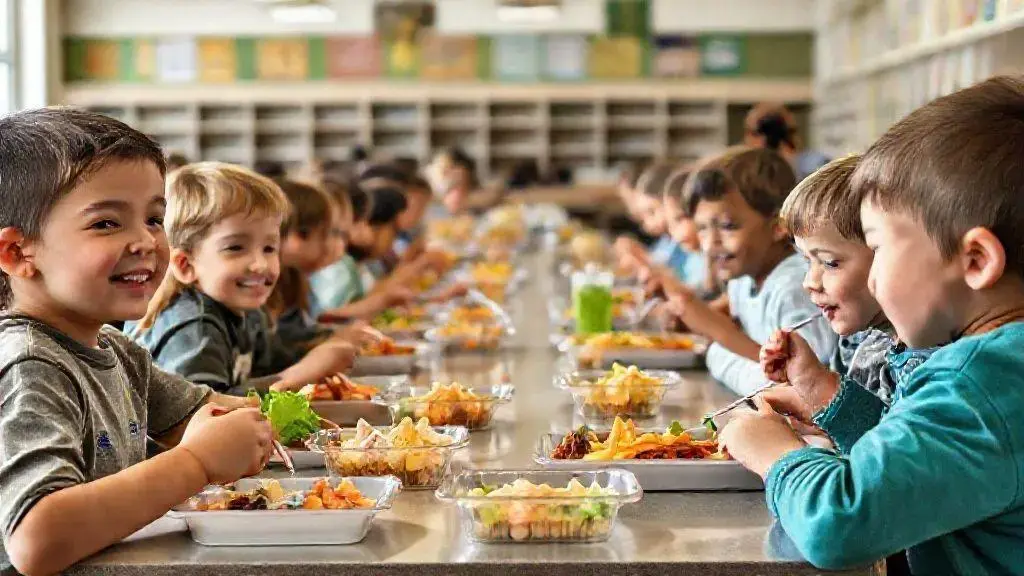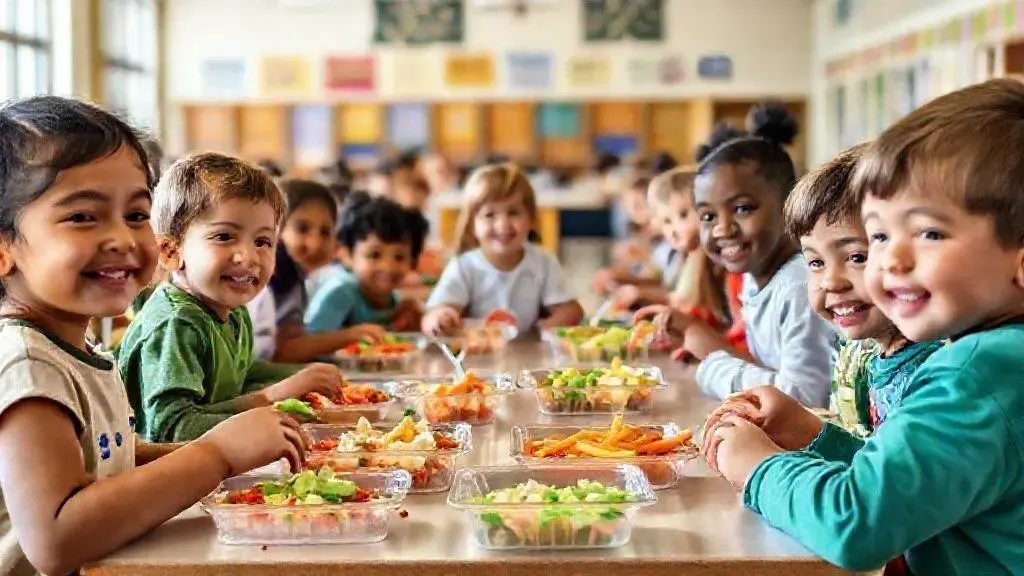Free school lunch expansions: a growing necessity

Free school lunch expansions provide nutritious meals to students, enhancing their health and academic performance while fostering community involvement and supporting local economies.
Free school lunch expansions have become a hot topic, especially as communities strive to provide better nutrition for their children. Have you ever wondered how these programs truly impact students?
The importance of school lunches for children
School lunches play a critical role in the daily lives of children, directly influencing their health and academic success. These meals provide essential nutrients that fuel growth and learning. School lunches ensure that even children from low-income families receive the nutrition they need.
Nutritional Benefits
Offering well-balanced meals reduces the risk of childhood obesity and related health issues. A proper diet improves children’s ability to focus in class and perform academically.
- Improves concentration and academic performance.
- Reduces risk of long-term health problems.
- Promotes healthy eating habits from a young age.
Additionally, school lunches can introduce children to a variety of foods. This exposure encourages them to try new flavors and develop better eating habits. Eating together also fosters social interactions among peers, which is vital for their emotional and social development.
Long-term Impact
The impact of school lunch programs extends beyond childhood. Providing nutritious meals sets the foundation for lifelong healthy habits. Studies show that children who participate in school lunch programs are more likely to adopt healthy eating patterns as adults.
Ensuring that children receive healthy meals at school can ultimately reduce healthcare costs in the future. By investing in their nutrition now, we can help break the cycle of poverty and health disparities. It’s essential to support policies that expand school lunch programs to benefit every child.
How free lunch programs work today
Free lunch programs are vital for ensuring that all children have access to nutritious meals at school. These programs are designed to provide healthy food options to students from low-income families. Today, many schools participate in free lunch initiatives to combat hunger and promote well-being.
Eligibility and Enrollment
Families can apply for free lunch programs through their school district. Typically, eligibility is based on household income levels. When children qualify, they can receive meals at no cost. This process aims to make it easier for parents to enroll their children in the program.
- Families fill out applications to determine eligibility.
- Once enrolled, children can receive free meals during school hours.
- Schools often provide both breakfast and lunch options.
As schools adapt to modern needs, many have expanded their menus, emphasizing healthy options. They now offer fruits, vegetables, whole grains, and lean proteins. This shift helps children develop better eating habits early in life. These meals are often prepared in alignment with federal nutritional guidelines.
Funding and Support
Funding for free lunch programs comes from federal and state sources, along with local contributions. Schools receive reimbursements for meals served to eligible students. This financial support allows schools to offer quality meals without burdening families.
Moreover, some communities have started initiatives to enhance these programs. Local farms may partner with schools to provide fresh produce. This partnership not only supports local agriculture but also ensures children get the freshest ingredients.
Overall, free lunch programs today are more than just a meal service. They are a crucial support system that addresses food insecurity, fosters learning, and promotes healthy eating habits among children. Every child deserves access to nutritious food, and these programs help make that a reality.
Impacts of expanded lunch programs on student health

Expanded lunch programs have a significant impact on student health across various dimensions. By providing access to nutritious meals, these programs can improve physical and mental well-being. When children receive balanced meals at school, they are better equipped to concentrate and learn.
Physical Health Benefits
One major advantage of expanded lunch programs is the promotion of physical health. Students who regularly eat healthy meals tend to have better growth and development. Additionally, these meals help combat childhood obesity.
- Healthy meals lower the risk of obesity.
- Improved nutrition supports children’s immune systems.
- Regular meals provide essential vitamins and minerals.
When children have access to fruits, vegetables, and whole grains, it establishes healthy eating habits early. These habits can last a lifetime, making it crucial for their future well-being.
Mental and Emotional Well-being
Nutrition doesn’t only affect physical health; it also plays a key role in mental health. Students who participate in free lunch programs often display better emotional stability. A well-fed child is more likely to focus, engage in class, and maintain positive interactions with peers.
Providing healthy meals can consequently help decrease incidents of behavior problems in schools. Children who are nourished are less irritable and more likely to work together harmoniously.
Furthermore, school lunches can foster a sense of community and connection among students. Eating together is a social activity that can improve relationships and support mental health.
As we can see, the impacts of expanded lunch programs extend beyond just filling stomachs. They promote overall health, enhance learning, and build a supportive school environment that benefits all students.
Community responses to lunch expansions
Community responses to lunch expansions have been overwhelmingly positive as people recognize the importance of feeding children nutritious meals. Many families and educators see these programs as crucial steps toward ensuring students receive the support they need during school hours.
Community Support
Local organizations and volunteers often rally to support lunch expansion programs. They understand that providing meals is not just about nutrition; it’s about building a strong foundation for children’s future. Schools frequently partner with community groups to raise awareness and gather resources.
- Food banks collaborate with schools to provide additional meals.
- Parents advocate for better food quality and variety.
- Health organizations promote awareness of the benefits of healthy meals.
These partnerships bring food and resources directly to students, creating a more extensive support network. When the community comes together, it strengthens the overall effectiveness of the lunch programs.
Challenges and Feedback
Despite the positive feedback, there can be challenges in implementing expanded lunch services. Some community members may have concerns about food quality or the sourcing of ingredients. Feedback from parents and students plays a vital role in adjusting menus to meet preferences and dietary needs.
Engagement from families is key. Many schools hold meetings to gather input, allowing parents to express their thoughts and suggestions. This dialogue helps ensure that the meals offered resonate with students, making the programs more appealing.
Furthermore, addressing cultural and dietary preferences in the menus is an essential aspect. Schools that thoughtfully consider these factors often find greater acceptance and participation from students and families alike.
Overall, the support from the community significantly enhances the success of lunch expansions, helping to create an environment where students can thrive both in health and education.
Future of school lunch policies
The future of school lunch policies is critical as more attention is given to child nutrition and health. As communities continue to advocate for better meal options, policies are evolving to meet new standards. These changes strive to provide meals that are not only nutritious but also appealing to students.
Emphasis on Nutrition
Future policies will likely place greater emphasis on nutritional guidelines. Schools will be encouraged to serve meals that adhere to and exceed federal standards. This means incorporating more fresh produce, whole grains, and lean proteins. By doing so, schools aim to combat health issues such as obesity and diabetes among children.
- Increasing fruits and vegetables in meal options.
- Reducing added sugars and unhealthy fats.
- Promoting whole grains as a staple in meals.
As more research highlights the link between nutrition and learning, schools may also adopt innovative practices to engage students in healthy eating.
Community Involvement
In the future, community involvement will be crucial. Schools will likely collaborate more with local farms, suppliers, and organizations to source ingredients. These partnerships not only support local economies but also provide fresher food options.
Families and local volunteers may become more active in school lunch programs, helping to facilitate meals and educate students about healthy eating. The goal is to build a supportive community around nutrition.
As concerns about food security rise, policies may aim to ensure that every child has access to nutritious meals, regardless of their background. This may include expanding eligibility for free lunch programs and increasing funding to support these initiatives.
Ultimately, the future of school lunch policies looks promising. With a focus on health, community support, and innovative practices, we can create a new era of school meals that benefit all students.
The future of school lunch programs is bright as communities recognize the importance of nutrition for students. With a focus on healthy meals, local partnerships, and active involvement from families, we can ensure that every child has access to nutritious food. These efforts not only support better learning but also foster healthier lifestyles. As we move forward, it’s essential to keep advocating for expanded lunch policies that prioritize the health of our future generations.
\n\n
\n
FAQ – Frequently Asked Questions About School Lunch Programs
What is the importance of school lunch programs?
School lunch programs provide essential nutrition to students, helping to improve their overall health and supporting better academic performance.
How are free lunch programs funded?
Free lunch programs are funded through federal and state government sources, as well as local contributions and school budgets.
What types of food are typically offered in school lunch programs?
School lunch programs aim to offer balanced meals that include fruits, vegetables, whole grains, and lean proteins to promote healthy eating.
How can parents get involved in school lunch programs?
Parents can get involved by volunteering in the cafeteria, providing feedback on menus, and advocating for healthy meal options in their schools.





